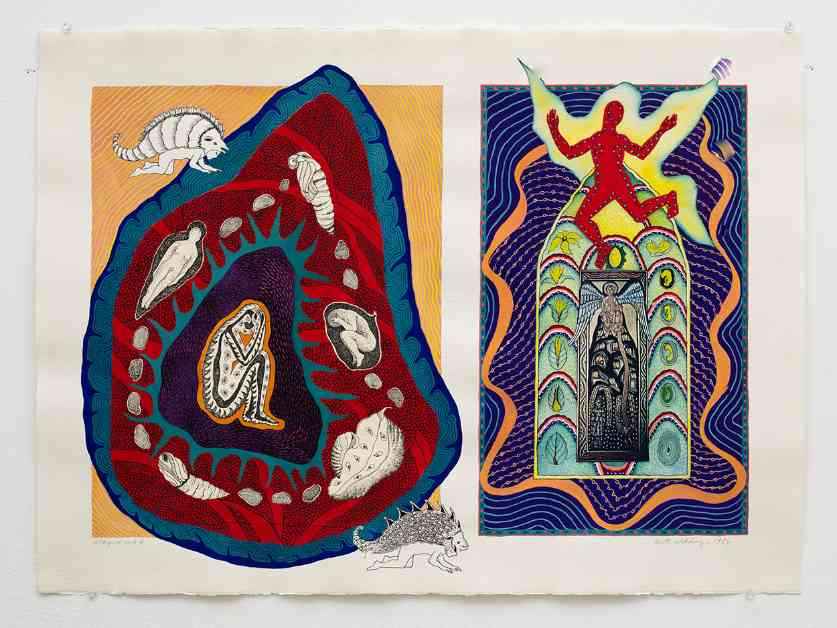Faith Wilding: An Ode to Nature and Feminism
Faith Wilding, a pioneering feminist artist born in 1943, is renowned for her groundbreaking work that blends environmentalism with feminist themes. Growing up in the midst of a lush forest, Wilding’s childhood experiences laid the foundation for her deep connection to nature, a bond that permeates her art to this day. Since the 1970s, her intricate drawings, inspired by illuminated manuscripts and botanical illustrations, have captivated audiences in urban art galleries, bridging the gap between city dwellers and the wonders of the natural world.
Currently, Wilding’s exhibit “Faith Wilding: Inside, Outside, Alive in the Shell” at the Anat Ebgi gallery in New York offers a retrospective of her 50-year career, showcasing a diverse range of works. From pieces that confront feminist issues head-on, such as “Raped Dress (Battle Dresses)” from 1993-94, to more decorative compositions that celebrate the beauty of nature, Wilding’s art serves as a powerful commentary on the world around us. By intertwining political messages with aesthetic delight, Wilding’s body of work challenges societal norms and envisions new possibilities for a better future. Let’s dive into the world of Faith Wilding as she shares insights on her art and life.
Exploring the Goddess of Nature
The exhibit opens with the striking “Bird of Paradise: Virgin Goddess,” a gold leaf painting created in 1978. This piece features a plant emerging from its bud, symbolizing the goddess of nature and life. The use of gold leaf, traditionally reserved for religious art, highlights the profound significance of nature in our lives. Wilding explains that during the 1970s, a period marked by feminist movements, there was a resurgence of interest in goddess worship as a form of protest against patriarchal religions. The artist’s choice to incorporate goddess imagery in her work reflects this feminist ethos and underscores the intrinsic link between nature and spirituality.
Reflecting on her early days as an artist, Wilding recalls her involvement in the groundbreaking Womanhouse project in Los Angeles. This transformative experience allowed her to experiment with new forms of artistic expression, such as crochet and performance art. As the environmental movement gained momentum, Wilding’s art began to draw parallels between the exploitation of nature and the subjugation of women. Her upbringing in a commune in Paraguay, where nature was revered and protected, instilled in her a deep sense of responsibility to safeguard the environment.
Embracing Beauty as a Powerful Tool
Wilding’s fascination with illuminated manuscripts and botanical motifs is evident in her artwork, where intricate patterns and vibrant colors abound. The artist’s love for beauty is rooted in her childhood desire to create art that would bring joy to others, particularly her mother. However, Wilding believes that beauty should not merely be pleasing; it should also provoke, challenge, and inspire. Quoting André Breton, she asserts that beauty must be “convulsive” to truly make an impact.
In her recent works, such as “Forest in Flames, Paraguay’s Last Trees” (2020) and “When the Trees Died” (2024), Wilding confronts the urgent issue of deforestation and its catastrophic effects on the environment. By highlighting the sacredness of trees and the vital role they play in sustaining life on Earth, Wilding’s art serves as a poignant reminder of the need to protect our planet. She underscores the critical importance of raising awareness about environmental issues and advocating for conservation efforts.
As Wilding’s art continues to evolve and inspire, she remains committed to using beauty as a “terrorist tactic,” a powerful force that can awaken people to the wonders of the natural world. Through her intricate drawings and thought-provoking messages, Wilding invites viewers to appreciate the beauty of the world around them and take action to preserve it for future generations.
Wilding’s artistic journey is a testament to the enduring power of art to challenge, provoke, and transform society. As she navigates the intersection of feminism, environmentalism, and aesthetics in her work, Wilding invites us to reflect on our relationship with nature and the profound impact it has on our lives. In a world where beauty and terror often coexist, Wilding’s art serves as a beacon of hope and inspiration, urging us to protect and cherish the natural world that sustains us all.












